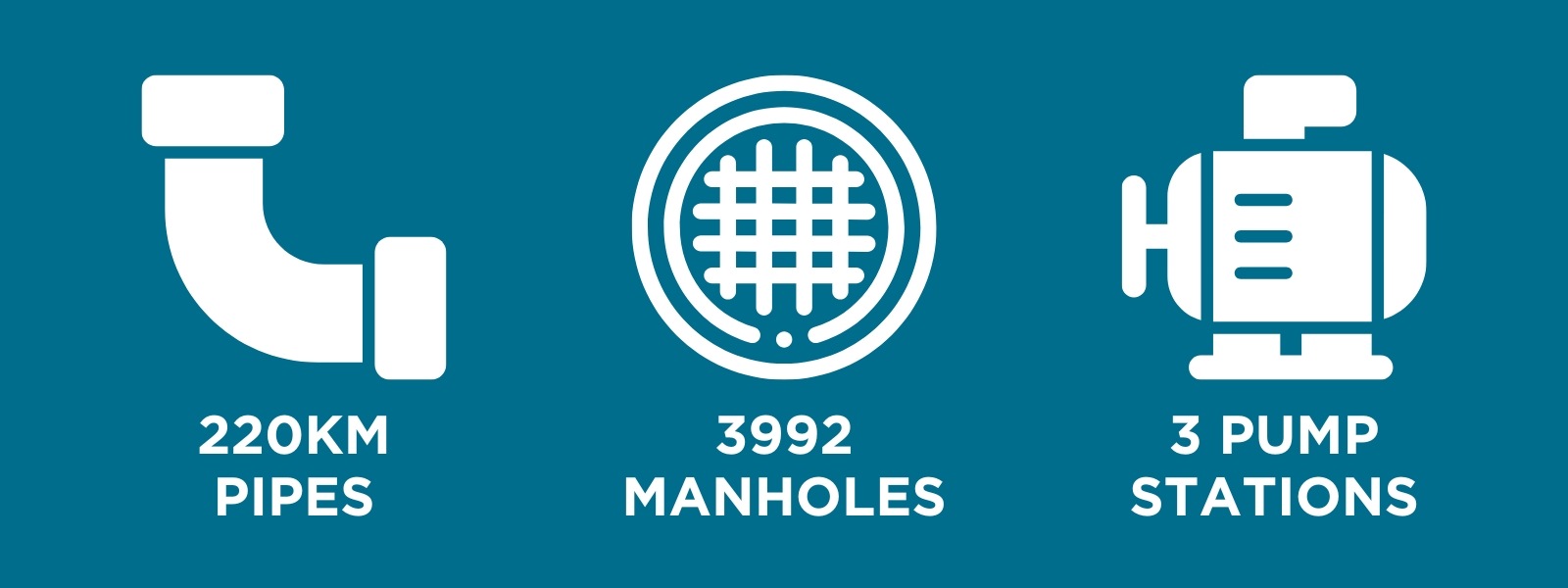Stormwater infrastructure

About our stormwater system
We own and maintain 220 kilometres of urban stormwater reticulation in urban areas around the Taupō District. From Atiamuri to Acacia Bay, Taupō to Tūrangi and Whakamaru to Whareroa, our stormwater system is designed to protect our communities against flooding.
In addition, we have a large number of dams and retention ponds in gullies around the Taupō District to assist in attenuating (holding back) stormwater flows, allowing water to slowly drain away following a rain event.
Stormwater assets

The services that are provided to the community through the stormwater assets are as follows:
- A reticulated stormwater system of pipes and channels (primary network) sufficient to cope with frequent rainfall events within the road reserves.
- A secondary stormwater system comprising swales, gullies, road, kerb and channel and both formal and informal overland flow paths sufficient to control stormwater from less frequent rainfall events
- Planning and building controls to restrict building in high flood risk areas, require minimum floor levels and require mitigation of stormwater runoff effects to prevent stormwater entry to habitable buildings.
- Planning and policy initiatives to minimise stormwater quality and quantity effects at source.
- Gross pollutant traps or similar treatment devices to reduce debris and contaminant levels in stormwater discharges.
Key components of stormwater system
Reticulation assets
Reticulation assets | Quantity |
|---|---|
Pipes | 220km |
Standard Manholes | 3992 |
Catchpit manholes | 20 |
Lamphole | 9 |
Inlets | 60 |
Raised manhole | 13 |
Pump Stations | 3 |
Stormwater quality improvements
| Stormwater quality improvements | Quantity |
|---|---|
Attenuation / detention ponds | 50 |
Quality Improvement Devices | 13 |
Enviropods (Catchpits) | 224 |
Disposal assets
| Disposal assets | Quantity |
|---|---|
| Pond outlet with debris screen | 32 |
Pond outlet with wingwall and debris screen | 20 |
| Lake outlet | 78 |
River outlet | 59 |
Gully outlet | 262 |
Land Outlet | 41 |
| Unknown outlet type | 82 |
Downstream Defenders fight the good fight
To help prevent contaminants from entering our lakes and rivers we have installed stormwater separator devices, known as ‘downstream defenders’, across the district. Once they are installed in the ground they are nearly invisible. They just keep on quietly and consistently filtering out the stormwater on its way to our lake and rivers.
The devices are designed to catch all the little stuff that gets flushed into the stormwater system by rain, and while these are smaller pollutants, they are also quite nasty ones: things like cigarette butts and plastic, oils and sediments which contain heavy metals, but also brake dust and rubber tyre particles from vehicles. The defenders are emptied every four months, with around a tonne of pollutants recovered from each, which adds up to around 30 tonnes of really nasty stuff that we stop from getting into the lake and our rivers each year.
There are many different types of stormwater treatment devices and each new site is assessed individually to determine what is the most appropriate device for each location.
As at August 2024, thirteen downstream defenders/Stormwater Treatment devices have been installed around the Taupō District:
Taupō
- Hawai Street
- Lake Terrace, near the Hole in One
- Nukuhau boat ramp
- Redoubt Road
- Ruapehu Street
- Sorrento Way
- Story Place
- Taharepa Road
- Tongariro Street
- Two Mile Bay boat ramp
- Waikato Street, downstream from the Control Gates
Tūrangi
- Kohineheke Reserve outlet
- Turanga Place outlet
Plans are in place for more treatment devices to be installed in Taupō, Mangakino and Tūrangi prioritising those locations where we have the largest discharges.
Additional resources
Urban water principles – Ngā wai manga
The Urban Water Working Group (UWWG), have developed a set of principles to guide decision making that promotes sustainable behaviours and the creation of water sensitive urban spaces. The UWWG are an independent group of urban water practitioners with expertise in policy, planning, engineering and urban design.
The principles promote drawing on mātauranga Māori, the lessons of the past, international best practice, the needs of our present communities, and a vision of a sustainable, resilient future.

